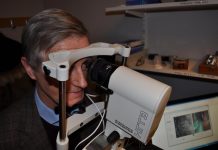New findings about the development of diabetic retinopathy represents a shift in the long-term understanding of these diabetes complications.
A University of Iowa-led study of diabetes-related vision impairment holds good news — and some bad news — for patients with signs of these disorders.

Scientists have long known that patients with diabetes mellitus — both Type 1 and Type 2 — are at high risk for developing diabetic retinopathy, the most common cause of irreversible blindness in adults.
Vision loss occurs due to microvascular damage to the retina. People with diabetes are typically not aware that they are also at risk for developing retinal diabetic neuropathy, a loss of the nerve cells in the retina.
For many years, scientists believed patients developed retinopathy and, as a result of the damage to the blood vessels, later developed neuropathy.
Continue Reading Below ↓↓↓
Doctors were focusing on early detection and treatment of retinopathy to prevent blindness, which they thought would then prevent the damage caused by neuropathy.
In this new study, however, researchers discovered that the sequence of events occurring in the retina due to diabetes is just the opposite of these long-held beliefs.
“What we’re finding here, unfortunately, is that the nerve damage actually does come first, before the vessel damage,” says Michael Abramoff, MD, PhD, UI professor in the Department of Ophthalmology and Visual Sciences and a member of the Stephen A. Wynn Institute for Vision Research, and senior author on the study. “Even people with diabetes who never get retinopathy can still develop this damage, and after many years, damage may be severe, similar to glaucoma.”
The study appeared online the week of April 25, 2016 in the journal PNAS (view study in PDF).
“Essentially, the order of damage in the retina from diabetes is different from what we originally thought, and preventing the effects of retinopathy by itself would not protect the nerves in the retina,” says Elliott Sohn, MD, UI associate professor in the Department of Ophthalmology and Visual Sciences and a member of the Stephen A. Wynn Institute for Vision Research, and first author on the study.
In the study, Sohn and Abramoff with their colleagues from the UI and the University of Amsterdam studied 45 people with diabetes and little to no diabetic retinopathy over a four-year span. They found “significant, progressive loss of the nerve fiber and ganglion cell layer,” proof of damage to the nerves before vascular changes typically found in the retina from diabetes.
At the same time, researchers found corresponding thinning of the nerve fiber layer in six donor eyes from patients with diabetes and little to no diabetic retinopathy, and the layer was considerably thinner than the layer in six donor eyes from patients who did not have diabetes. Similar results were found in diabetic mouse models in this study.
The good news, Abramoff says, is that better understanding of the sequence of damage may lead to new treatments that focus on preventing the nerve damage, and thereby hopefully also preventing retinopathy.
Other researchers from the Stephen A. Wynn Institute for Vision Research involved in this study include Chunhua Jiao; Woojin Jeong; Allison Garmager; Murat Kucukevcilioglu; Robert Mullins, , PhD; and Markus Kuehn, PhD; and Milan Sonka, PhD, from the Iowa Institute for Biomedical Imaging and the UI College of Engineering.
Source: University of Iowa Health Care
Journal: Proceedings of the National Academy of Sciences
Funder: National Institutes of Health
Continue Reading Below ↓↓↓










